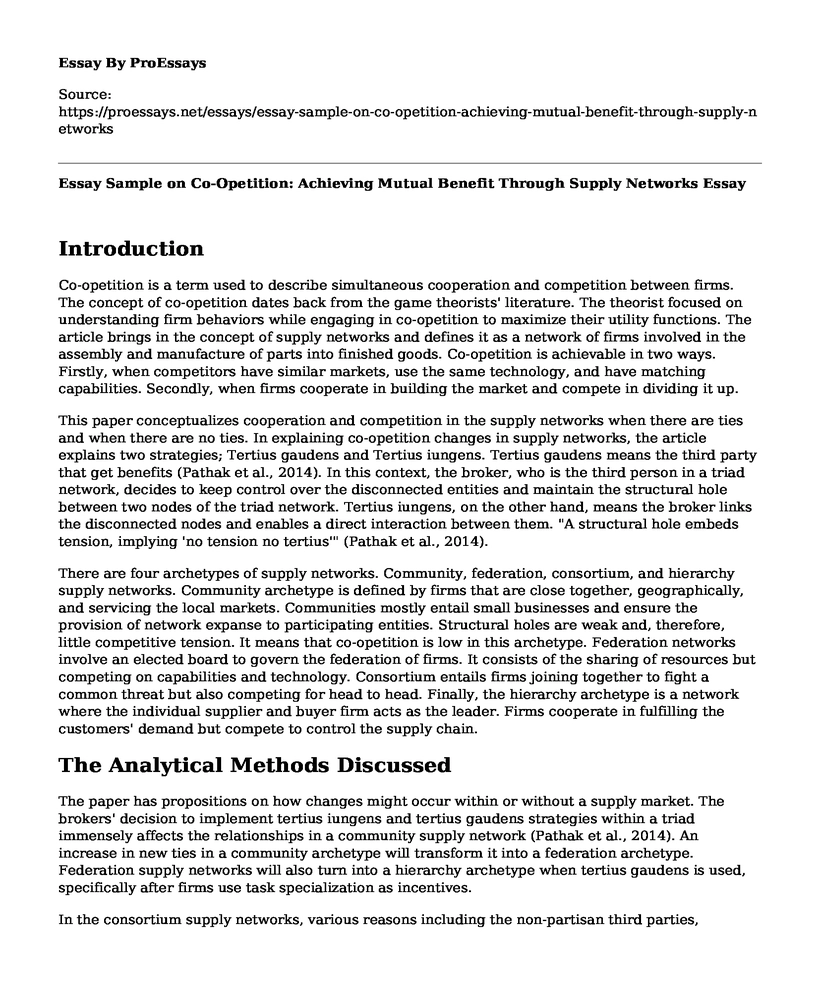Introduction
Co-opetition is a term used to describe simultaneous cooperation and competition between firms. The concept of co-opetition dates back from the game theorists' literature. The theorist focused on understanding firm behaviors while engaging in co-opetition to maximize their utility functions. The article brings in the concept of supply networks and defines it as a network of firms involved in the assembly and manufacture of parts into finished goods. Co-opetition is achievable in two ways. Firstly, when competitors have similar markets, use the same technology, and have matching capabilities. Secondly, when firms cooperate in building the market and compete in dividing it up.
This paper conceptualizes cooperation and competition in the supply networks when there are ties and when there are no ties. In explaining co-opetition changes in supply networks, the article explains two strategies; Tertius gaudens and Tertius iungens. Tertius gaudens means the third party that get benefits (Pathak et al., 2014). In this context, the broker, who is the third person in a triad network, decides to keep control over the disconnected entities and maintain the structural hole between two nodes of the triad network. Tertius iungens, on the other hand, means the broker links the disconnected nodes and enables a direct interaction between them. "A structural hole embeds tension, implying 'no tension no tertius'" (Pathak et al., 2014).
There are four archetypes of supply networks. Community, federation, consortium, and hierarchy supply networks. Community archetype is defined by firms that are close together, geographically, and servicing the local markets. Communities mostly entail small businesses and ensure the provision of network expanse to participating entities. Structural holes are weak and, therefore, little competitive tension. It means that co-opetition is low in this archetype. Federation networks involve an elected board to govern the federation of firms. It consists of the sharing of resources but competing on capabilities and technology. Consortium entails firms joining together to fight a common threat but also competing for head to head. Finally, the hierarchy archetype is a network where the individual supplier and buyer firm acts as the leader. Firms cooperate in fulfilling the customers' demand but compete to control the supply chain.
The Analytical Methods Discussed
The paper has propositions on how changes might occur within or without a supply market. The brokers' decision to implement tertius iungens and tertius gaudens strategies within a triad immensely affects the relationships in a community supply network (Pathak et al., 2014). An increase in new ties in a community archetype will transform it into a federation archetype. Federation supply networks will also turn into a hierarchy archetype when tertius gaudens is used, specifically after firms use task specialization as incentives.
In the consortium supply networks, various reasons including the non-partisan third parties, Network Administered Organizations (NAO), and opportunistic behaviors lead to transformation to another archetype and competitive tensions within the networks. In the hierarchical systems, the use of tertius iungens increases cohesion and cooperation and reduces competition among upstream suppliers. When intermediate suppliers use the same strategy in this archetype, it increases the competitive tensions. On the other hand, the use of tertius gaudens in hierarchical supply networks by upstream suppliers and buyers results in structural holes and increases competition in the system.
The Major Findings in the Article
Three insights can come from the propositions and the concepts above. Firstly, the local broker's choice triggers significant changes in supply networks. Secondly, the enactment of tertius gaudens and tertius iungens can present different outcomes depending on which direction the systems will evolve and who is making a choice. Lastly, co-opetition exists in an ever-changing balance between two conflicting opposites. The paper illustrates that the individual options in a supply network can bring desired or undesired outcomes at a specific level, leading to transformations of one archetype to another.
References
Pathak, S., Wu, Z., & Johnston, D. (2014). Towards a Theory of Co-opetition of Supply Networks. Journal of Operations Management, 32,(5), 254-267.
Cite this page
Essay Sample on Co-Opetition: Achieving Mutual Benefit Through Supply Networks. (2023, Apr 10). Retrieved from https://proessays.net/essays/essay-sample-on-co-opetition-achieving-mutual-benefit-through-supply-networks
If you are the original author of this essay and no longer wish to have it published on the ProEssays website, please click below to request its removal:
- The Budgeting and Financial Planning Approach for A2 Milk Company
- Paper Example on Succession Planning
- Alibaba's Strategy Analysis of Relationship With Stakeholders Paper Example
- Essay Sample on Netflix Strategic Plan
- Essay Example on Johnson and Johnson's Pharmaceuticals
- Essay Example on Leadership: A Crucial Concept for Everyday Life
- Essay Example on Stakeholders: How Tesla Relied on Investors in Early Years







